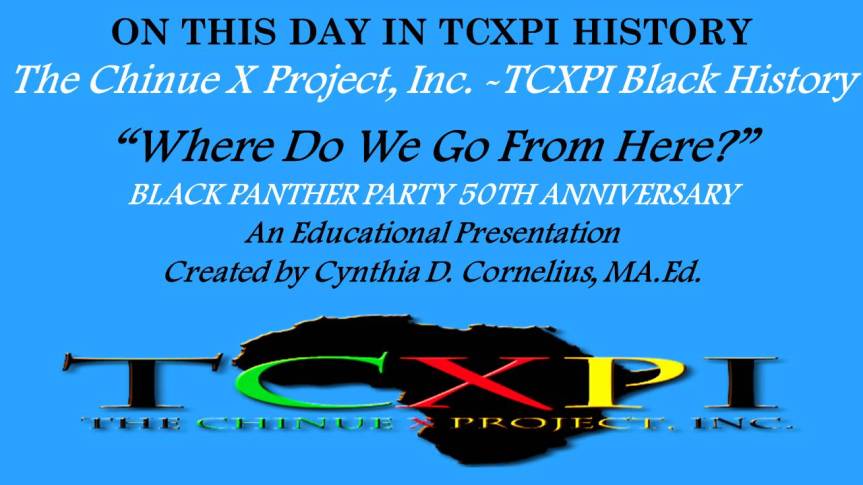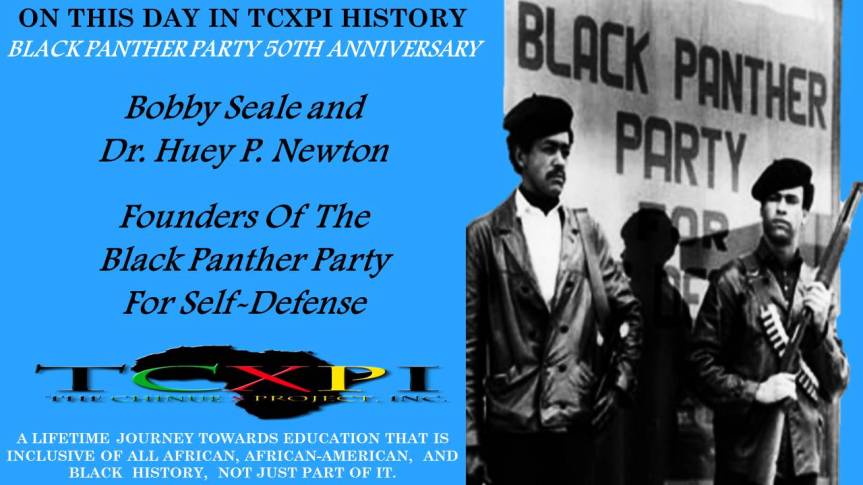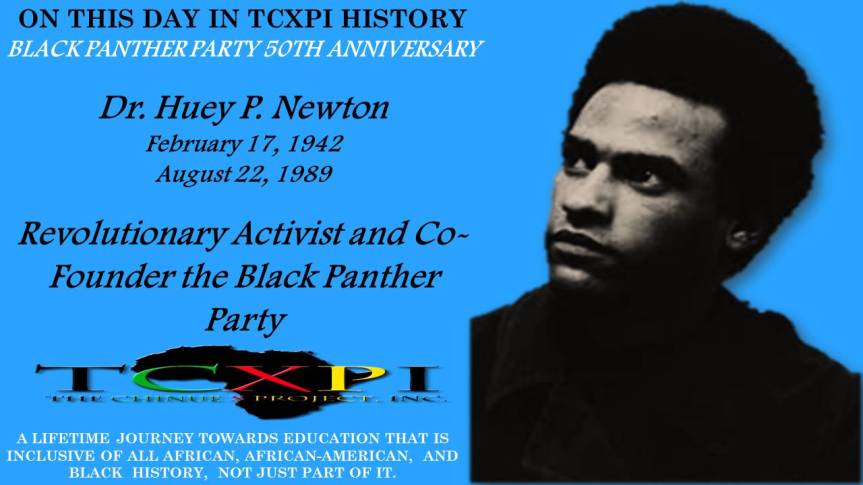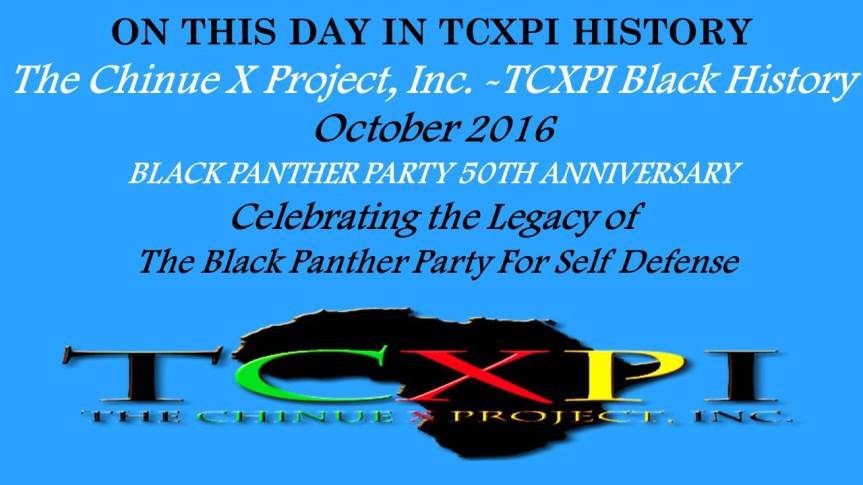
TCXPI is an online Afrocentric Educational
For More Daily Black History, visit:
http://thechinuexprojectinc.blogspot.com/
https://www.facebook.com/TCXPIHistory
https://www.facebook.com/TCXPI?ref=hl
https://www.facebook.com/TheMediaAndTheBlackCommunityTcxpi?ref=hl
Resource Service established in Maryland as a non-profit. It seeks to bring awareness to the many contributions made by African and Black Americans in World and Human Civilization.
For information on TCXPI, please visit: http://tcxpi.org/
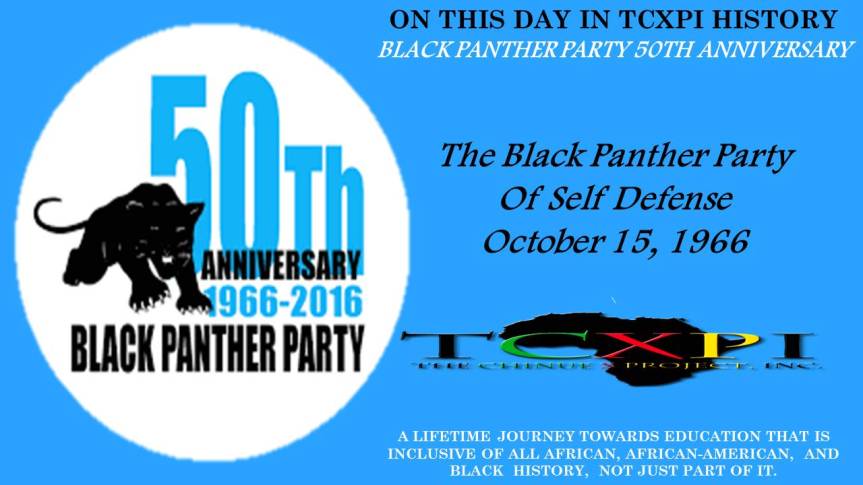
There was no specific event that launched the Black Panther Party, but the generally agreed-upon date is Oct. 15, 1966. The one person who does not agree on that date is Seale, who was reached by phone Friday, as his plane landed after a speech at the University of Oregon. Seale said the founding date was Oct. 22, 1966, which was his 30th birthday and the day he and the late Huey Newton finished the “10 Point Platform and Program” for the Black Panther Party for Self Defense (as it was originally called).
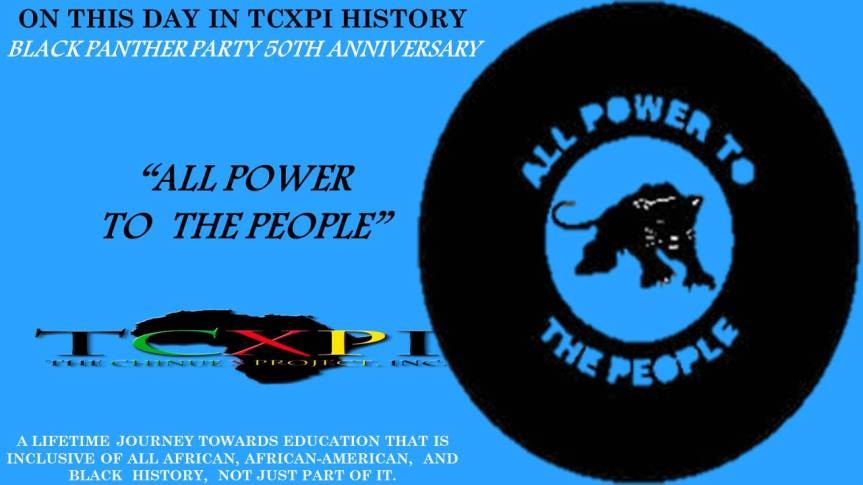
The Black Panther Party was the most famous group born out of the Black Power Movement. Because of the group’s inherent link to the Black Power Movement, and the group’s slogan of “Black Power,” many people, both black and white, believed, and continue to believe, that the Black Panther Party was a group with racial motives. However, this conceptualization of the Party was, and is, incorrect. While the Black Panther Party began as an outgrowth of the black civil rights movement, the Panthers quickly evolved into a revolutionary vanguard with a non-racial, class-oriented agenda. Read more at: http://fau.digital.flvc.org/islandora/object/fau%3A1476

TCXPI (The Chinue X Project, Inc.) Presents
October Is Black Panther Party Month! October 3
The Black Panther Party For Self-Defense originated in Oakland, California, by founders Huey Newton and Bobby Seale. The Original six members of the Black Panthers included Elbert “Big Man” Howard, Sherman Forte, Reggie Forte, Little Bobby Hutton, and Newton and Seale. They adopted the Black Panther symbol from an independent political party established the previous year by Black residents of Lowndes County, Alabama. The Panthers also supported the Black Power movement, which stressed racial dignity and self-reliance.
The Party established patrols in Black communities to monitor police activities and protect the residents from police brutality. The Black Panther Party combined elements of socialism and Black Nationalism. It promoted the development of strong Black-controlled institutions, calling for Blacks to work together to protect their rights and to improve their economic and social conditions.
The Panthers also emphasized class unity, criticizing the Black middle class for acting against the interests of other, less fortunate Blacks.
First Original Six Members of the Black Panther Party; Huey Newton, Bobby Seale, Bobby Hutton, Sherwin Forte, Elbert Howard, Reggie Forte
Read more at: https://www.marxists.org/history/usa/workers/black-panthers/

On This Day In TCXPI History
(The Chinue X Project, Inc.) TCXPI Presents The Black Panther Party 50th Anniversary
October Is Black Panther Party Month! October 4
The Women Of The Black Panther Party
(From left to right-) Fredrika Newton, Kathleen Cleaver, Elaine Brown, Angela Davis, Afeni Shakur, Assata Shakur.
Read more: http://www.forharriet.com/2015/05/say-it-loud-9-black-women-in-black.html#ixzz4Ly33eNmA
On This Day In TCXPI History
(The Chinue X Project, Inc.) TCXPI Presents The Black Panther Party 50th Anniversary
October Is Black Panther Party Month! October 5
In 1966, while at Oakland City College, Huey P. Newton and Bobby Seale organized the Black Panther Party For Self-Defense.
Seale became Chairman while Newton became Minister of Defense.
The Panthers practiced militant self-defense of minority communities against the U.S. government, and fought to establish revolutionary socialism through mass organizing and community based programs. The party was one of the first organizations in U.S. history to militantly struggle for ethnic minority and working class emancipation — a party whose agenda was the revolutionary establishment of real economic, social, and political equality across gender and color lines.
Sources:
https://www.marxists.org/history/usa/workers/black-panthers/
https://ia802701.us.archive.org/26/items/SeizeTheTimeTheStoryOfTheBlackPantherParty/STT.pdf
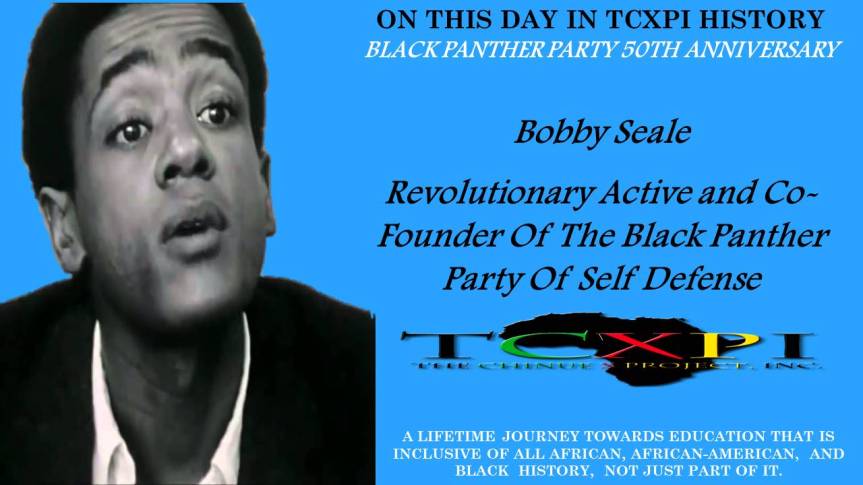
On This Day In TCXPI History
(The Chinue X Project, Inc.) TCXPI Presents The Black Panther Party 50th Anniversary
October Is Black Panther Party Month! October 6
Robert George Seale was born on October 22, 1936, to George and Thelma Seale. His father was a master carpenter, and his mother was a home maker. The oldest of three children, Seale grew up with his younger brother Jon, his sister Betty, and his cousin Alvin Turner.
Source: http://pabook2.libraries.psu.edu/palitmap/bios/Seale__Bobby.html
Note – These pictures are assumed to be in the public domain, if this is not the case, please let us know by emailing us at thecxpi@gmail.com so that we can give credit or remove them from the web site as desired.
On This Day In TCXPI History
(The Chinue X Project, Inc.) TCXPI Presents The Black Panther Party 50th Anniversary
October Is Black Panther Party Month! October 7
Huey P. Newton Revolutionary Activist and Co-Founder the Black Panther Party
QUOTES
“The first lesson a revolutionary must learn is that he is a doomed man.”
—Huey P. Newton
Huey P. Newton was born in Monroe, Louisiana, on February 17, 1942, and named after former governor Huey P. Long. In 1966, Newton and Bobby Seale founded the left-wing Black Panther Party for Self Defense in Oakland, California. The organization was central to the Black Power movement, making headlines with its controversial rhetoric and militaristic style. Newton faced a number of criminal charges over the years and at one point fled to Cuba before returning to the U.S. and earning his doctorate. Struggling with drug and alcohol addiction in his later years, he was killed in 1989 in Oakland.
Social activist Huey Percy Newton was born on February 17, 1942, in Monroe, Louisiana. Newton helped establish the African-American political organization the Black Panther Party, and became a leading figure in the Black Power movement of the 1960s. The youngest of seven siblings, he and his family moved to Oakland, California when Newton was a toddler. Though later stating he was close to his family, the youngster had a difficult time early in life, which was reflected in highly erratic behavior at school and on the streets.
Source: http://www.biography.com/people/huey-p-newton-37369
Note – These pictures are assumed to be in the public domain, if this is not the case, please let us know by emailing us at thecxpi@gmail.com so that we can give credit or remove them from the web site as desired.
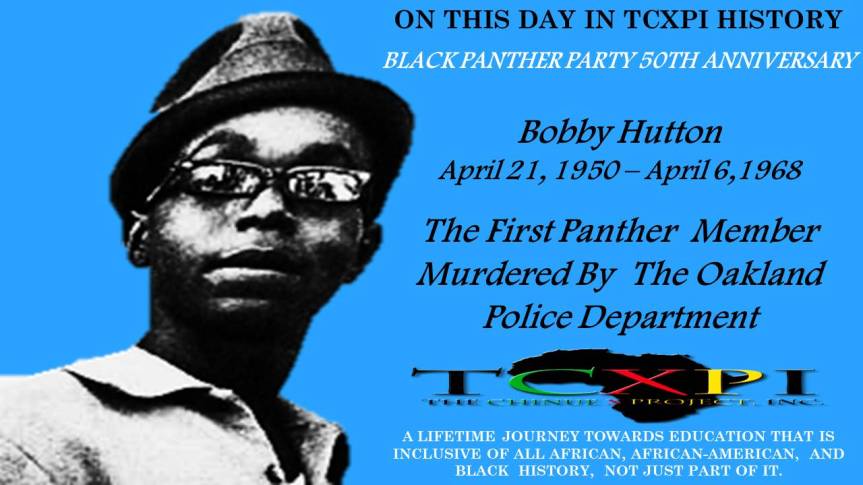
On This Day In TCXPI History
(The Chinue X Project, Inc.) TCXPI Presents The Black Panther Party 50th Anniversary
October Is Black Panther Party Month! October 8
BOBBY HUTTON – The Day My Beloved Brother Comrade was Murdered
On April 6, 1968, two days after Martin Luther King had been murdered, I got dressed and prepared to go to Central Headquarters of the Black Panther Party (BPP) along with Panthers Jimmy Charley and Terry Claridy. I read a chapter of the “Red Book – Quotations by Chairman Mao” before I left. We arrived at Central Headquarters at 45th and Grove St. to get assigned to various locations to sell the Party’s newspaper “The Black Panther,” collect donations and pass out leaflets in the community about the barbecue for the “Free Huey Newton” defense committee to be held at then called – Defremery Park on April 7th.
Later that evening, around 4pm, other Panthers and I, in groups of two and three, were circulating in the community and going to high schools spreading the word that despite the murder of Dr. King, they should stay cool, lay low and refrain from all counterproductive and random violence, because riots would cause nothing but mass genocide. If trouble erupted, it would be open season on blacks and the BPP would be the first attacked.
Around 6pm, some Party members and I met at a Panther’s apartment off San Pablo Ave. We decided that we would ride in three vehicles transporting food and supplies for the barbecue picnic and at the same time we would observe and patrol the police activities in the Black community.
Around 7:30pm, after patrolling and picking up supplies for the rally, two policemen turned their cruiser south observing and following us onto 28th street and Union street where we had stopped for a minute for Eldridge Cleaver who had to urinate. Eldridge and L’il Bobby Hutton were riding in a 1961 Ford with several other Panthers. I was riding shotgun, in the center of the back seat, armed with a banana clip 30 caliber carbine. Panther Charles Bursey was to the left of me and Donnell Lankford was to the right. The officers pulled their cruiser to a stop in the middle of the street side by side with these vehicles. (The 1961 Ford with Florida license plates had been observed all week because it was known by the Oakland Police as a Panther vehicle.) Gunfire erupted at once, two wild shots were followed instantly by a deluge of lead that riddled the squad cars and shots were fired by police into the rear window of the 1954 Ford in which I was riding.
More policemen flocked to the shooting scene. Charles Bursey was able to get out of the car and escape the scene. Donnell Lankford, who was to the right of me, attempted to open the door so we could take cover, but the door was jammed. The door finally came open, but as soon as we tried to exit the vehicle, there were about a dozen police with their guns and shotguns drawn and thrust into our faces. They were making racist, insulting remarks while we were lying face down, handcuffed behind our backs, helpless on the pavement. They made statements such as, “you niggers just lost Martin Luther King and if you make one move we will not hesitate to blow your heads off.”
We were then put into the police paddy wagon. Donnell, John L. Scott and I were the first to be arrested. The over- reactionary pigs sprayed mace into our eyes after we were already handcuffed and helpless. As the police wagon drove away from the scene, I could barely see out the back, but it appeared to me that there were black people running behind the wagon saying, “Free these brothers, you racist cops.” I told my comrades in the police wagon that this was a deliberate ambush, attempting to commit genocide against the BPP.
The booking officer asked me if I wanted to make a statement after being booked. I said no, I was taking the 5th amendment until I consulted with my attorney, Charles Garry. They put Lankford, Scott and me into different holding cells. I could hear racist statements like, “They should kill Eldridge Cleaver. He’s like a wild animal running amok.” Note: the ambush of other Party members was still going on at this time. Later that night, Harold Rodgers, Charles Garry’s assistant attorney, visited me in my cell and told me that one Party member did not survive. That was the Party’s first member and treasurer, Bobby James Hutton.
Long Live the Spirit of Lil Bobby Hutton.
Terry M. Cotton, former political prisoner and BPP member
Source: http://www.itsabouttimebpp.com/Memorials/Bobby_Hutton_Murdered.html
Note – These pictures are assumed to be in the public domain, if this is not the case, please let us know by emailing us at thecxpi@gmail.com so that we can give credit or remove them from the web site as desired.

On This Day In TCXPI History
October Is Black Panther Party Month! October 9
Born in Queens, New York, Joanne Deborah Bryon, a Nationalist and Activist, spent her early childhood alternately with her grandparents in Wilmington, North Carolina, and with her mother in New York. She dropped out of high school at seventeen but returned to college during her early twenties, attending Manhattan Community College and City College of New York. She was married for a year while in school and continued to use her married name.
She became a student activist and participated in rent strikes, antiwar demonstrations, and sitins, protesting racial injustices. As a reflection of her new political consciousness and her commitment to her African heritage, she changed her name to Assata (“she who struggles”) Shakur (“the thankful”). The assassination of the Rev. Dr. Martin Luther King Jr. in 1968 precipitated Assata Shakur’s embrace of the militant Black Power movement and her rejection of nonviolence.
Assata Shakur moved to Oakland, California, where she joined the Black Panther Party (BPP) in Oakland and helped organize community education programs, demonstrations, and political rallies. When she returned to New York, she became a key member of the BPP’s Harlem chapter. She helped organize and staff the Free Breakfast Program for community children, oversaw the planning of a free clinic, and coordinated member health care, first aid, and community outreach.

On This Day In TCXPI History
(The Chinue X Project, Inc.) TCXPI Presents The Black Panther Party 50th Anniversary
October Is Black Panther Party Month! October 10
The Black Panthers: Ten Point Platform and Program
- WE WANT FREEDOM. WE WANT POWER TO DETERMINE THE DESTINY OF OUR BLACK AND OPPRESSED COMMUNITIES. We believe that Black and oppressed people will not be free until we are able to determine our destinies in our own communities ourselves, by fully controlling all the institutions which exist in our communities.
- WE WANT FULL EMPLOYMENT FOR OUR PEOPLE. We believe that the federal government is responsible and obligated to give every person employment or a guaranteed income. We believe that if the American businessmen will not give full employment, then the technology and means of production should be taken from the businessmen and placed in the community so that the people of the community can organize and employ all of its people and give a high standard of living.
- WE WANT AN END TO THE ROBBERY BY THE CAPITALISTS OF OUR BLACK AND OPPRESSED COMMUNITIES. We believe that this racist government has robbed us and now we are demanding the overdue debt of forty acres and two mules. Forty acres and two mules were promised 100 years ago as restitution for slave labor and mass murder of Black people. We will accept the payment in currency which will be distributed to our many communities. The American racist has taken part in the slaughter of our fifty million Black people. Therefore, we feel this is a modest demand that we make.
- WE WANT DECENT HOUSING, FIT FOR THE SHELTER OF HUMAN BEINGS. We believe that if the landlords will not give decent housing to our Black and oppressed communities, then housing and the land should be made into cooperatives so that the people in our communities, with government aid, can build and make decent housing for the people.
- WE WANT DECENT EDUCATION FOR OUR PEOPLE THAT EXPOSES THE TRUE NATURE OF THIS DECADENT AMERICAN SOCIETY. WE WANT EDUCATION THAT TEACHES US OUR TRUE HISTORY AND OUR ROLE IN THE PRESENT-DAY SOCIETY. We believe in an educational system that will give to our people a knowledge of the self. If you do not have knowledge of yourself and your position in the society and in the world, then you will have little chance to know anything else.
- WE WANT COMPLETELY FREE HEALTH CARE FOR ALL BLACK AND OPPRESSED PEOPLE. We believe that the government must provide, free of charge, for the people, health facilities which will not only treat our illnesses, most of which have come about as a result of our oppression, but which will also develop preventive medical programs to guarantee our future survival. We believe that mass health education and research programs must be developed to give all Black and oppressed people access to advanced scientific and medical information, so we may provide our selves with proper medical attention and care.
- WE WANT AN IMMEDIATE END TO POLICE BRUTALITY AND MURDER OF BLACK PEOPLE, OTHER PEOPLE OF COLOR, ALL OPPRESSED PEOPLE INSIDE THE UNITED STATES. We believe that the racist and fascist government of the United States uses its domestic enforcement agencies to carry out its program of oppression against black people, other people of color and poor people inside the united States. We believe it is our right, therefore, to defend ourselves against such armed forces and that all Black and oppressed people should be armed for self defense of our homes and communities against these fascist police forces.
- WE WANT AN IMMEDIATE END TO ALL WARS OF AGGRESSION. We believe that the various conflicts which exist around the world stem directly from the aggressive desire of the United States ruling circle and government to force its domination upon the oppressed people of the world. We believe that if the United States government or its lackeys do not cease these aggressive wars it is the right of the people to defend themselves by any means necessary against their aggressors.
- WE WANT FREEDOM FOR ALL BLACK AND OPPRESSED PEOPLE NOW HELD IN U. S. FEDERAL, STATE, COUNTY, CITY AND MILITARY PRISONS AND JAILS. WE WANT TRIALS BY A JURY OF PEERS FOR All PERSONS CHARGED WITH SO-CALLED CRIMES UNDER THE LAWS OF THIS COUNTRY. We believe that the many Black and poor oppressed people now held in United States prisons and jails have not received fair and impartial trials under a racist and fascist judicial system and should be free from incarceration. We believe in the ultimate elimination of all wretched, inhuman penal institutions, because the masses of men and women imprisoned inside the United States or by the United States military are the victims of oppressive conditions which are the real cause of their imprisonment. We believe that when persons are brought to trial they must be guaranteed, by the United States, juries of their peers, attorneys of their choice and freedom from imprisonment while awaiting trial.
- WE WANT LAND, BREAD, HOUSING, EDUCATION, CLOTHING, JUSTICE, PEACE AND PEOPLE’S COMMUNITY CONTROL OF MODERN TECHNOLOGY. When, in the course of human events, it becomes necessary for one people to dissolve the political bonds which have connected them with another, and to assume, among the powers of the earth, the separate and equal station to which the laws of nature and nature’s God entitle them, a decent respect to the opinions of mankind requires that they should declare the causes which impel them to the separation. We hold these truths to be self-evident, that all men are created equal; that they are endowed by their Creator with certain unalienable rights; that among these are life, liberty, and the pursuit of happiness. That to secure these rights, governments are instituted among men, deriving their just powers from the consent of the governed; that, whenever any form of government becomes destructive of these ends, it is the right of the people to alter or to abolish it, and to institute a new government, laying its foundation on such principles, and organizing its powers in such form as to them shall seem most likely to effect their safety and happiness. Prudence, indeed, will dictate that governments long established should not be changed for light and transient causes; and, accordingly, all experience hath shown that mankind are most disposed to suffer, while evils are sufferable, than to right themselves by abolishing the forms to which they are accustomed. But, when a long train of abuses and usurpation, pursuing invariably the same object, evinces a design to reduce them under absolute despotism, it is their right, it is their duty, to throw off such government, and to provide new guards for their future security.
Source: https://www.linkedin.com/pulse/ten-point-platform-program-formation-black-panther-party-bobby-seale
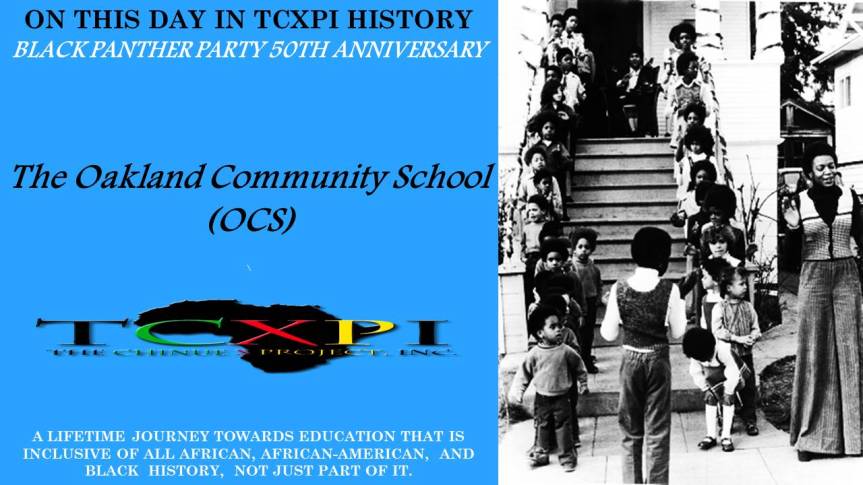
On This Day In TCXPI History
October Is Black Panther Party Month! October 11
The Oakland Community School (OCS)
Historically, the educational programs of the BPP started long before the OCS with the vision of the party’s leaders.
As early as 1967 Huey Newton and Bobby Seale began speaking to high school youth at San Francisco/Bay Area public schools.
In 1969, in U.S. cities where there were strong BPP chapters, liberation schools staffed by volunteer party members opened in storefronts, churches and homes. These after-school programs were created to give academic support to black and other poor youth.
These community school programs created a forum for young people to explore a factual history of America and a sense of connection and community.
The Oakland Community School (OCS) was one of the most well-known and well-loved programs of the Black Panther Party.
Point Five of the Black Panther Party’s original 1966 Ten Point Platform and Program, emphasized the need to provide an education that, among other things, taught African American and poor people about their history in the United States.
To this end, the Oakland Community School became a locale for a small, but powerful group of administrators, educators, and elementary school students whose actions to empower youth and their families challenged existing public education concepts for black and other poor and racially marginalized communities during the 1970s and 1980s.
Image: Huey P. Newton (seated on porch) watches Donna Howell
and the children of the Intercomunal Youth Institute.
Photo: Lauryn Williams, 1972
Note – These pictures are assumed to be in the public domain, if this is not the case, please let us know by emailing us at thecxpi@gmail.com so that we can give credit or remove them from the web site as desired.
For More Daily Black History, visit:
http://tcxpi.org/
http://www.tcxpissp.com/
http://thechinuexprojectinc.blogspot.com/
https://www.facebook.com/TheMediaAndTheBlackCommunityTcxpi?ref=hl
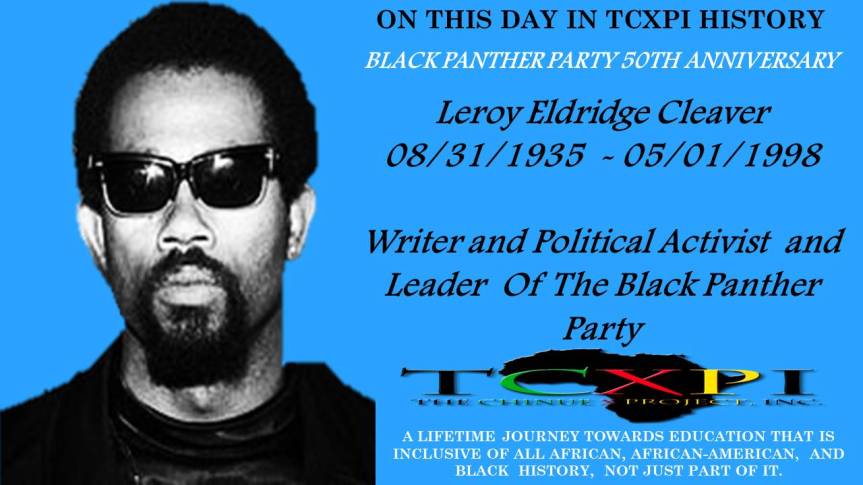
On This Day In TCXPI History
(The Chinue X Project, Inc.) TCXPI Presents The Black Panther Party 50th Anniversary
October Is Black Panther Party Month! October 12
Leroy Eldridge Cleaver (August 31, 1935 – May 1, 1998) better known as Eldridge Cleaver, was a writer and political activist who became an early leader of the Black Panther Party. His book Soul On Ice is a collection of essays praised by The New York Times Book Review at the time of its publication as “brilliant and revealing.”
Cleaver went on to become a prominent member of the Black Panthers, having the titles Minister of Information, and Head of the International Section of the Panthers while in exile in Cuba and Algeria. As editor of the official Panther’s newspaper, Cleaver’s influence on the direction of the Party was rivaled only by founders Huey P. Newton and Bobby Seale. Cleaver and Newton eventually fell out with each other, resulting in a split that weakened the Party.
Read more at: http://www.rhizzone.net/forum/topic/2535/
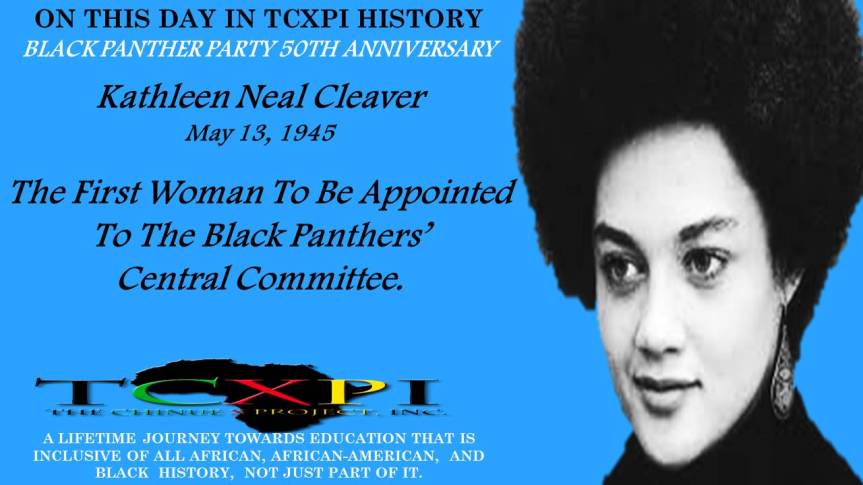
On This Day In TCXPI History
(The Chinue X Project, Inc.) TCXPI Presents The Black Panther Party 50th Anniversary
October Is Black Panther Party Month! October 13
Kathleen Neal was born in Dallas, Texas, on 13th May, 1945. Her father, Ernest Neal, taught sociology at Wiley College before moving to the Tuskegee Institute in Alabama. He later joined the Foreign Service and the family lived in India, Liberia, Sierra Leone and the Philippines.
Kathleen returned to the United States to finish her education. While studying at Barnard College she became involved in the civil rights movement. In 1967 she left college to work full-time for the Student Nonviolent Coordinating Committee (SNCC). The following year she met Eldridge Cleaver and moved from New York to San Francisco to join the Black Panther Party (BPP). The couple married on 27th December, 1967.
Kathleen Cleaver became the BPP’s National Communications Secretary and helped to organize the campaign to get Huey Newton released from prison. She was also the first woman to be appointed to the Black Panthers Central Committee.
On 6th April, 1968 eight BPP members, including Eldridge Cleaver, Bobby Hutton and David Hilliard, were travelling in two cars when they were ambushed by the Oakland police. Cleaver and Hutton ran for cover and found themselves in a basement surrounded by police. The building was fired upon for over an hour. When a tear-gas canister was thrown into the basement the two men decided to surrender. Cleaver was wounded in the leg and so Hutton said he would go first. When he left the building with his hands in the air he was shot twelve times by the police and was killed instantly.
Cleaver was arrested and charged with attempted murder. He was given bail and in November, 1968, he fled to Mexico with Kathleen. Later the couple moved to Cuba. They also spent time in Algeria.
While in exile Cleaver had disagreements with Huey Newton and in 1971 he was expelled from the Black Panther Party. Soon afterwards Cleaver formed the Revolutionary Peole’s Communication Network and Kathleen returned to the United States to establish the party in New York.
While living abroad Cleaver underwent a mystical conversion to Christianity. He now rejected his former political beliefs describing the system in Cuba as “voodoosocialism”. He also wrote an article for the New York Times where he argued “With all its faults, the American political system is the freest and most democratic in the world.”
Source: http://spartacus-educational.com/USACcleaverK.htm
Note – These pictures are assumed to be in the public domain, if this is not the case, please let us know by emailing us at thecxpi@gmail.com so that we can give credit or remove them from the web site as desired.
For More Daily Black History, visit: http://tcxpi.org/
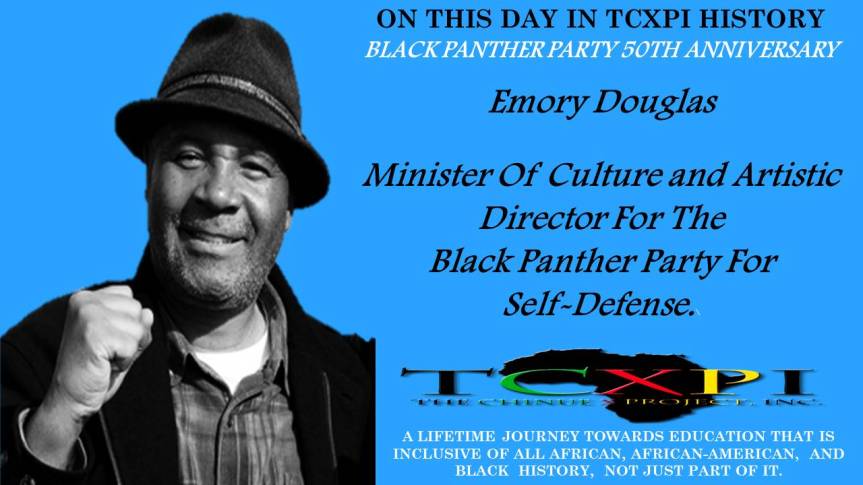
On This Day In TCXPI History
(The Chinue X Project, Inc.) TCXPI Presents The Black Panther Party 50th Anniversary
October Is Black Panther Party Month! October 14
Emory Douglas, Minister Of Culture and Artistic Director For The Black Panther Party For Self-Defense.
Emory Douglas was born in 1943 in Grand Rapids, Michigan, and has been a resident of the Bay Area since 1951. He became the Minister of Culture for the Black Panther Party in 1967, a role he held until the party disbanded in the early 1980s.
During the Party’s active years he served as the art director overseeing the design and layout of the Black Panther, the Party’s weekly newspaper.
Douglas was trained as a commercial artist at City College of San Francisco and has been the subject of several solo exhibitions. His work has also been in numerous exhibitions about the history of the Black Panther Party, including shows at the Arts & Culture Conference of the Black Panther Party in Atlanta, GA in 2008 and “The Black Panther Rank and File” at the Yerba Buena Center for the Arts, San Francisco in 2006. Most recently his work was the subject of a solo exhibition at Urbis, Manchester, UK in 2008-2009. In 2007, artist Sam Durant curated a solo exhibition of Douglas’ work at the MOCA Pacific Design Center in Los Angeles, “Black Panther: The Revolutionary Art of Emory Douglas,” which is the inspiration for the presentation at the New Museum. The same year, Rizzoli published a book with the same title that included essays and interviews about Douglas’s work and his relationship to the Black Panther Party. Douglas’s work has also been presented at the 2008 Biennale of Sydney, Australia; the African American Art & Cultural Complex, San Francisco; Richmond Art Center, CA; and the Station Museum of Contemporary Art, Houston.
Sources: http://www.gclass.org/artists/emory-douglas
For More Daily Black History, visit: http://tcxpi.org/
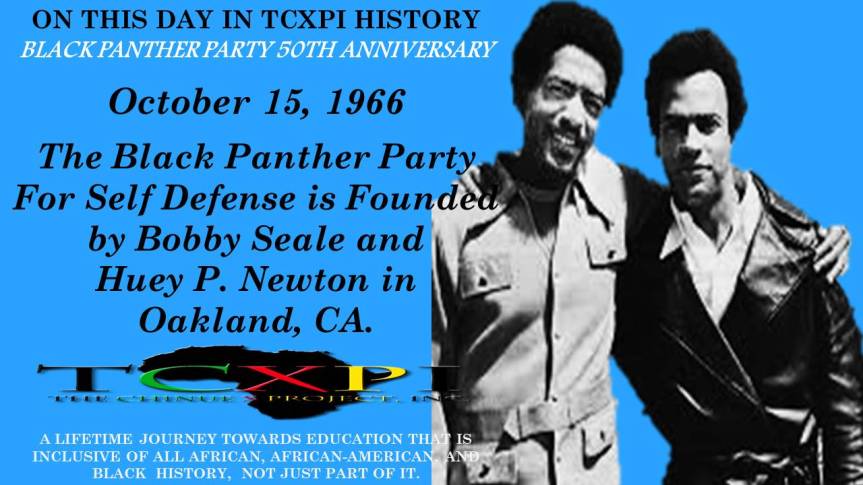
On This Day In TCXPI History
(The Chinue X Project, Inc.) TCXPI Presents The Black Panther Party 50th Anniversary
October Is Black Panther Party Month! October 15
Huey Newton and Bobby Seale founded the Black Panther Party for Self-Defense, in Oakland California, October 15, 1966.
The Black Panther Party practiced militant self-defense of minority communities against the U.S. government, and fought to establish revolutionary socialism through mass organizing and community based programs.
The party was one of the first organizations in U.S. history to militantly struggle for ethnic minority and working class emancipation — a party whose agenda was the revolutionary establishment of real economic, social, and political equality across gender and color lines.
Black Panther Theory: The practices of the late Malcolm X were deeply rooted in the theoretical foundations of the Black Panther Party. Malcolm had represented both a militant revolutionary, with the dignity and self-respect to stand up and fight to win equality for all oppressed minorities; while also being an outstanding role model, someone who sought to bring about positive social services; something the Black Panthers would take to new heights.
The BPP of Self-Defense followed Malcolm’s belief of international working class unity across the spectrum of color and gender, and thus united with various minority and white revolutionary groups. From the tenets of Maoism they set the role of their Party as the vanguard of the revolution and worked to establish a united front, while from Marxism they addressed the capitalist economic system, embraced the theory of dialectical materialism, and represented the need for all workers to forcefully take over the means of production.
Black Panther History: On April 25th, 1967, the first issue of The Black Panther, the party’s official news organ, goes into distribution. In the following month, the party marches on the California state capital fully armed, in protest of the state’s attempt to outlaw carrying loaded weapons in public. Bobby Seale reads a statement of protest; while the police respond by immediately arresting him and all 30 armed Panthers. This early act of political repression kindles the fires to the burning resistance movement in the United States; soon initiating minority workers to take up arms and form new Panther chapters outside the state.
Source:
https://www.marxists.org/history/usa/workers/black-panthers/
(Accessed on 10/14/2015)
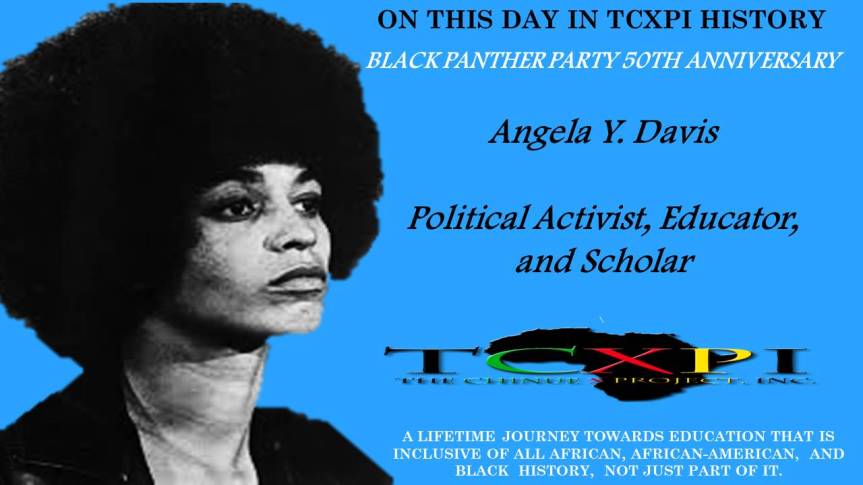
On This Day In TCXPI History
(The Chinue X Project, Inc.) TCXPI Presents The Black Panther Party 50th Anniversary
October Is Black Panther Party Month! October 16
Angela Davis, Political Activist, Educator, and Scholar, was born on January 26, 1944, in the “Dynamite Hill” area of Birmingham, Alabama. The area received that name because so many African American homes in this middle class neighborhood had been bombed over the years by the Ku Klux Klan. Her father, Frank Davis, was a service station owner and her mother, Sallye Davis, was an elementary school teacher. Davis’s mother was also active in the National Association for the Advancement of Colored People (NAACP), when it was dangerous to be openly associated with the organization because of its civil rights activities. As a teenager Davis moved to New York City with her mother, who was pursuing a Master’s degree at New York University. While there she attended Elizabeth Irwin High School, a school considered leftist because a number of its teachers were blacklisted during the McCarthy era for their earlier alleged Communist activities.
In 1961 Davis enrolled in Brandeis University in Waltham, Massachusetts. While at Brandeis, Davis also studied abroad for a year in France and returned to the U.S. to complete her studies, joining Phi Beta Kappa and earning her B.A. (magna cum laude) in 1965. Even before her graduation, Davis, so moved by the deaths of the four girls killed in the bombing of Sixteenth Street Baptist Church in her hometown in 1963, that she decided to join the civil rights movement. By 1967, however, Davis was influenced by Black Power advocates and joined the Student Nonviolent Coordinating Committee (SNCC) and then the Black Panther Party. She also continued her education, earning an M.A. from the University of California at San Diego in 1968. Davis moved further to the left in the same year when she became a member of the American Communist Party.
In 1969 Angela Davis was hired by the University of California at Los Angeles (UCLA) as an assistant professor of philosophy, but her involvement in the Communist Party led to her dismissal. During the early 1970s she also became active in the movement to improve prison conditions for inmates. That work led to her campaign to release the “Soledad (Prison) Brothers.” The Soledad Brothers were two African American prisoners and Black Panther Party members, George Jackson and W. L. Nolen, who were incarcerated in the late 1960s.
On August 7, 1970, Jonathan Jackson, the younger brother of George Jackson, attempted to free prisoners who were on trial in the Marin County Courthouse. During this failed attempt, Superior Court Judge Harold Haley and three others including Jonathan Jackson were killed. Although Davis did not participate in the actual break-out attempt, she became a suspect when it was discovered that the guns used by Jackson were registered in her name. Davis fled to avoid arrest and was placed on the FBI’s most wanted list. Law enforcement captured her several months later in New York. During her high profile trial in 1972, Davis was acquitted on all charges.
The incident nonetheless generated an outcry against Davis and then California Governor Ronald Reagan campaigned to prevent her from teaching in the California State university system. Despite the governor’s objection, Davis became a lecturer in women’s and ethnic studies at San Francisco State University in 1977.
As a scholar, Davis has authored five books, including Angela Davis: An Autobiography in 1974; Women, Race, and Class in 1983; and Blues Legacies and Black Feminism: Gertrude “Ma” Rainey, Bessie Smith, and Billie Holiday in 1999.
The Black Past: Remembered and Reclaimed
http://www.blackpast.org/aah/davis-angela-1944-0

On This Day In TCXPI History
(The Chinue X Project, Inc.) TCXPI Presents The Black Panther Party 50th Anniversary
October Is Black Panther Party Month! October 17
Pete and Charlotte O’Neal, Founders of the Kansas , Missouri Chapter of the Black Panther Party in 1968
Fifty years ago, the Panthers were formed in California as a militia group to protect African-Americans from police. In 1967, they gained notoriety when – armed and dressed in their characteristic black berets – they marched into the California state capital.
“It started out as self-defense,” said Charlotte O’Neal, Pete O’Neal’s wife. “But then we saw all the things that needed to be addressed.“
Shortly after Pete O’Neal formed the Kansas City Panthers, his future wife Charlotte O’Neal joined as an 18-year-old.
“After I met him, after I saw the commitment that he had to uplift the community, it was over for me,” said Charlotte O’Neal. “That’s what I wanted to do in my life.“
That service included feeding hundreds of children breakfast each morning. Kansas City’s St. Mark’s Church, where Charlotte O’Neal spoke to 41 Action News, was one of the locations. Other Panther public service efforts included a free health clinic, sickle cell anemia testing, political education classes and literacy classes.
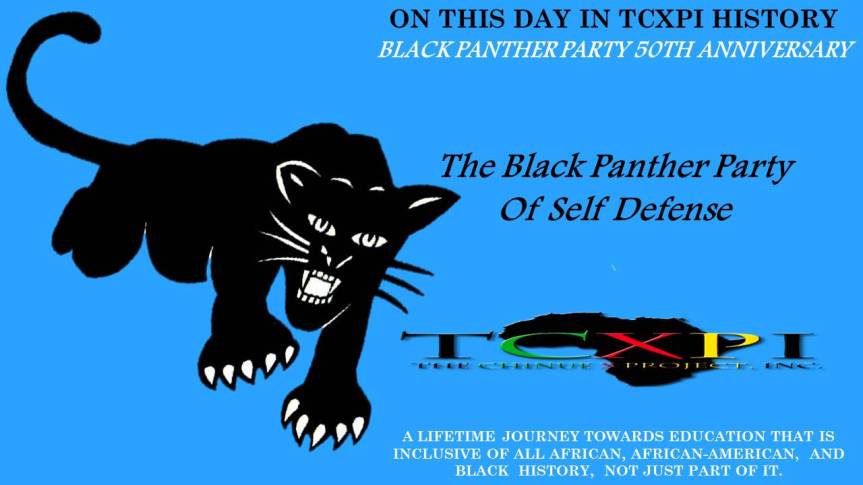
On This Day In TCXPI History
(The Chinue X Project, Inc.) TCXPI Presents The Black Panther Party 50th Anniversary
October Is Black Panther Party Month! October 18
The Art Of The Black Panther Party For Defense – The Use Of Imagery In Resistance.
Black Panther Party was founded 50 years ago in Oakland, on Oct. 15, 1966, and within two years it had chapters across the country. The New York Times is taking this opportunity to explore the Black Panthers’ legacy, through their iconic use of imagery and how they were covered in our own pages.
The Black Panther Party is often associated with armed resistance, but one of the most potent weapons in its outreach to African-Americans in cities across the country was its artwork. In posters, pamphlets and its popular newspaper, The Black Panther, the party’s imagery was guided by the vision of Emory Douglas, its minister of culture.
His art came from many sources. As a teenager in San Francisco during the late 1950s and early 1960s, Mr. Douglas found himself incarcerated at the Youth Training School in Ontario, Calif., where he got involved with its printing shop. He went on to study graphic design at San Francisco City College, where he developed a deep interest in the Black Arts Movement, the artistic arm of the Black Power Movement.
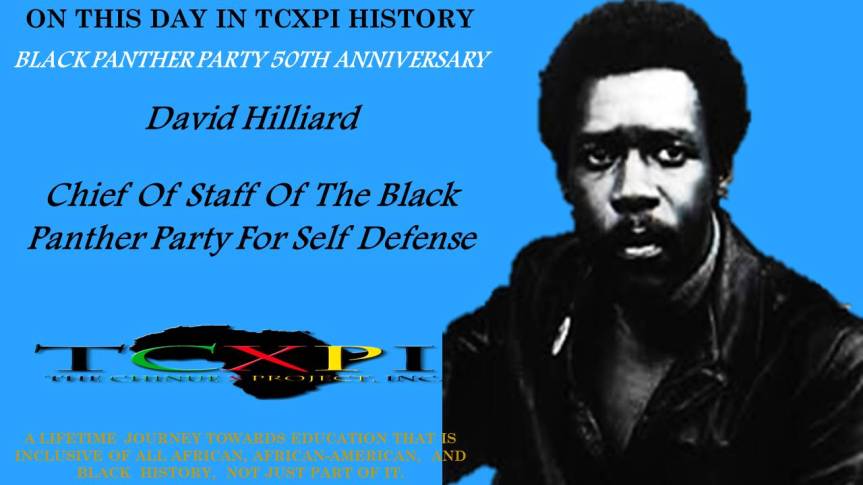
On This Day In TCXPI History
(The Chinue X Project, Inc.) TCXPI Presents The Black Panther Party 50th Anniversary
October Is Black Panther Party Month! October 19
David Hilliard was born in Oakland, California, on May 15, 1942. He was one of the first members of the Black Panther Party (BPP)and became Chief Of Staff of the organization.
Hilliard was arrested in January, 1968, for passing out leaflets at Oakland Technical High School. When Huey Newton was arrested in September, 1968, Hilliard took over the command of the BPP.
On April 6, 1968 eight BPP members, including Hilliard, Eldridge Cleaver and Bobby Hutton, were travelling in two cars when they were ambushed by the Oakland police. Cleaver and Hutton ran for cover and found themselves in a basement surrounded by police. The building was fired upon for over an hour. When a tear-gas canister was thrown into the basement the two men decided to surrender. Cleaver was wounded in the leg and so Hutton said he would go first. When he left the building with his hands in the air he was shot twelve times by the police and was killed instantly.
The activities of the Black Panthers came to the attention of J. Edgar Hoover and the FBI. Hoover described the Panthers as “the greatest threat to the internal security of the country” and in November 1968 ordered the FBI to employ “hard-hitting counter-intelligence measures to cripple the Black Panthers”.
On 3rd December, 1969, Hilliard was arrested and charged with threatening the life of President Richard Nixon. He was accused of saying at a meeting “we will kill Nixon”. Later that month Hilliard was found guilty of carrying a gun and was sentenced to a 6 months in prison.
Hilliard was also charged with shooting at the police during the incident when Bobby Hutton was killed. In July, 1971, Hilliard was found guilty of this offence and received a one to ten year prison term.
In 1993 Hilliard joined Fredrika Newton in establishing the Huey P. Newton Foundation. The non-profit educational organization provides community-based programs, which include literacy, voter outreach and health-related components. The following year David Hilliard published his autobiography, This Side of Glory (1994).
http://spartacus-educational.com/USAChilliard.htm
Note – These pictures are assumed to be in the public domain, if this is not the case, please let us know by emailing us at thecxpi@gmail.com so that we can give credit or remove them from the web site as desired.
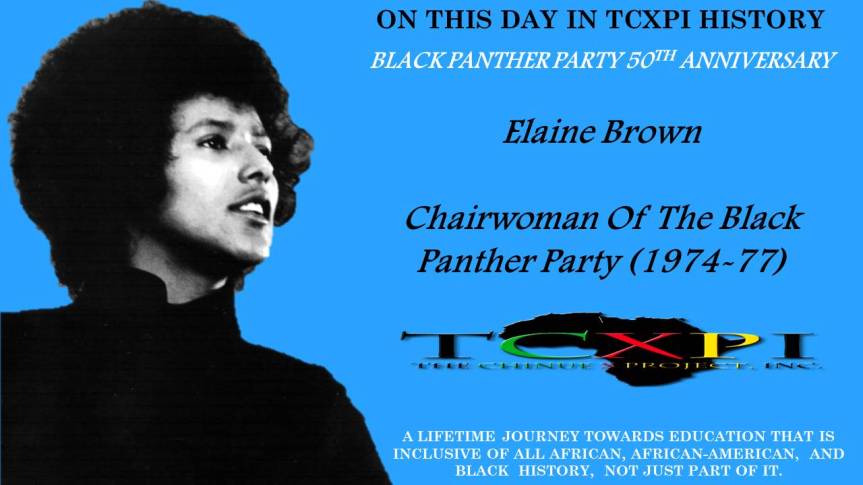
On This Day In TCXPI History
(The Chinue X Project, Inc.) TCXPI Presents The Black Panther Party 50th Anniversary
October Is Black Panther Party Month! October 20
Elaine Brown, Chairwoman of the Black Panther Party, 1974-77
From 1974 to 1977, Elaine Brown was Chairwoman of the Black Panther Party. As a Panther, Brown also ran twice for a position on the City Council of Oakland, California. Since the 1970s she has been active in prison and education reform and juvenile justice.
Born in heavily black and impoverished North Philadelphia, Pennsylvania in 1943, Brown attended a predominantly white experimental elementary school where she studied ballet and classical piano. Brown’s childhood was starkly divided between the comfort of her schooling and the realities of her home life. Following high school Brown entered Temple University but left the campus for Los Angeles, California before the end of her first year.
In Los Angeles Brown worked at a well-paying Hollywood nightclub and developed a key relationship with writer Jay Kennedy – to whom Brown credits her early political education. Brown began giving piano lessons in a Watts housing project in the summer of 1967. Having lived in moderate affluence since moving to Los Angeles, her experiences in Watts served as a social and racial awakening, and soon Brown began writing for the radical Black Congress Newspaper, Harambee. Brown’s first direct exposure to the Black Panther Party came through local appeals for the Huey Newton Legal Defense Fund. Before the end of April 1968, following the assassination of Dr. Martin Luther King Jr., and the imprisonment of Panther leader Eldridge Cleaver, Brown attended her first Black Panther party meeting.
Source: http://www.blackpast.org/aaw/brown-elaine-1943
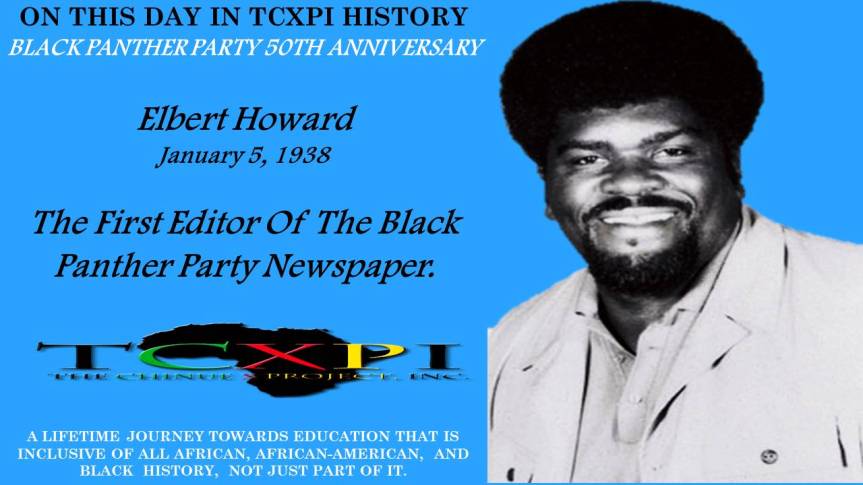
On This Day In TCXPI History
(The Chinue X Project, Inc.) TCXPI Presents The Black Panther Party 50th Anniversary
October Is Black Panther Party Month! October 21
Elbert “Big Man” Howard is an African-American Writer, Lecturer, Community Organizer and Political Activist. One of the six original founding members of the Black Panther Party, and the first editor of the Black Panther Party newspaper, he currently resides in Sonoma County, California.
Mr. Howard was born in Chattanooga, Tennessee on January 5th, 1938, an only child, the son of Emma and Anderson Howard. His father, having died before he turned two, Elbert was raised by his mother and extended family, in particular, his Aunt Mary and Uncle Walter. Although he was surrounded by a loving family and community, Elbert was very aware that he lived in a racist, unjust, segregated society. He witnessed daily atrocities, including the whipping of one of his relatives by the Ku Klux Klan.
In 1956, a young Howard joined the Air Force, both as a way of helping his ailing mother, and as a lucrative means of escape from the segregated south with its limited opportunities. He was soon shipped overseas and spent about four years in Europe. His experiences, both as a fire-fighter in the Air Force, and as an African-American in Europe, contributed greatly to his development and knowledge.
More than four years later, Elbert was discharged from the Air Force near Oakland, California and, since he liked it there, decided to stay.
After obtaining employment, Howard started attending Grove Street College on his GI bill. It was there that he met Huey P. Newton and Bobby Seale. Their mutual interests in Black History, political science, revolutionary politics and social revolution made for heated discussions and meetings that soon surpassed what was being offered in the classrooms. These early exchanges of dialogue were the pivotal points for what was soon to become the Black Panther Party.
An activist with the Black Panther Party from 1966 to 1974, Big Man (as he came to be known) held many positions and worked on numerous projects. He served as the first BPP Newspaper editor, and as the Deputy Minister of Information; he helped to develop the BPP newspaper and build it to a two hundred thousand copy per week circulation. He was a member of the BPP Central Committee, and a Coordinator of National and International Support Committees. As a Panther Party spokesman, he traveled and lectured on the conditions and treatment of African-Americans and other minorities in America. He helped build Solidarity Committees in Europe, Africa, Asia, and the Caribbean.
As a student at Peralta Community College, Big Man organized a prisoner re-entry and peer counseling program on the campus. As a community organizer and activist, he helped to develop the first BPP Survival program: the Free Breakfast for School Children program. Howard also helped to develop a Free Community Health Clinic, a Sickle Cell Screening Program, and a Free Transportation to Prisons program.
As a teacher and mentor to young BPP members, and as a political educator, Big Man spoke at schools, colleges, union meetings, and to various Human Rights groups.
Working with the Berkeley Community Action Program, Big Man helped the Organization of Disabled Persons to pressure the government to provide wheelchair access ramps on city streets and government buildings.
In addition to the African-American community, Howard worked to unify groups from the Chicano, Native American, Asian, and European communities to combat racism and discrimination in housing, jobs, and education. He also coordinated the purchases and management of real estate owned by the Black Panther Party’s forty-five chapters and branches.
Source: http://www.bigman-bpp.com/about/
Note – These pictures are assumed to be in the public domain, if this is not the case, please let us know by emailing us at https://www.facebook.com/TCXPIHistory/ so that we can give credit or remove them from the web site as desired.
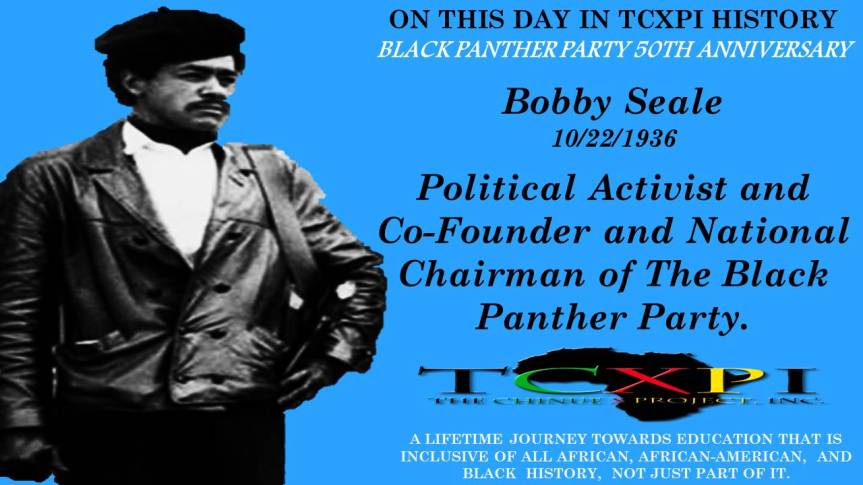
On This Day In TCXPI History
(The Chinue X Project, Inc.) TCXPI Presents The Black Panther Party 50th Anniversary
October Is Black Panther Party Month! October 22
Bobby Seale, Political Activist and Co-Founder and National Chairman of The Black Panther Party.
Bobby Seale was born Robert George Seale on October 22, 1936, in Dallas, Texas, the oldest of three children. Seale’s family moved to California and he attended Berkeley High School.It was during this period that he started to become politically minded.
Bobby Seale joined the U.S Air Force in 1955, but was discharged in 1959 following an altercation with a superior officer.
In September 1962, Seale met Huey Newton at a rally protesting the Kennedy Administration’s blockade of Cuba. Kindred spirits, the pair quickly became friends, and that year marked the sprouting of Seale’s political radicalism, which was deepened when Seale attended a speech given by Malcolm X.
By 1966, Seale and Newton were ready to organize their beliefs, and they formed the Black Panthers (later renamed the Black Panther Party). Originally created as an armed force protecting the black community from the notoriously racist Oakland police, the Panthers’ reputation grew and with it the scope of the organization itself. The Panthers became a new voice in the Civil Rights Movement, and they rejected outright the mainstream movement’s nonviolent approach as well as the “Back to Africa” teachings put forth by the more radical Black Nationalists.
The Panthers focused much of their energies on community outreach, and the California movement spawned chapters across the nation. By 1968, Seale decided that a public account of the formation and history of the Panthers was needed, so he wrote Seize the Time: The Story of the Black Panther Party and Huey P. Newton (published in 1970). That same year, Seale was arrested while protesting at the Democratic National Convention in Chicago. He and seven other defendants, thereafter known as the Chicago Seven, were tried for conspiracy to incite riots in a circus-like atmosphere that resulted in Seale being sentenced to four years in prison for contempt of court . Seale was also tried during this period for the murder of a fellow Panther suspected of being a police informant. The trial ended with a hung jury.
After his release from prison, Bobby Seale renounced violence as a means to an end and began the task of reorganizing the Panthers, which had fallen into disarray in his absence. In 1973, he also ran for mayor of Oakland and came in second out of nine candidates. But Seale soon grew tired of politics and turned again to writing, producing A Lonely Rage in 1978 and a cookbook titled Barbeque’n with Bobby in 1987.
In 2002, Seale moved back to Oakland to work with young political activists to spark social change.
Source: http://www.biography.com/people/bobby-seale-9477529
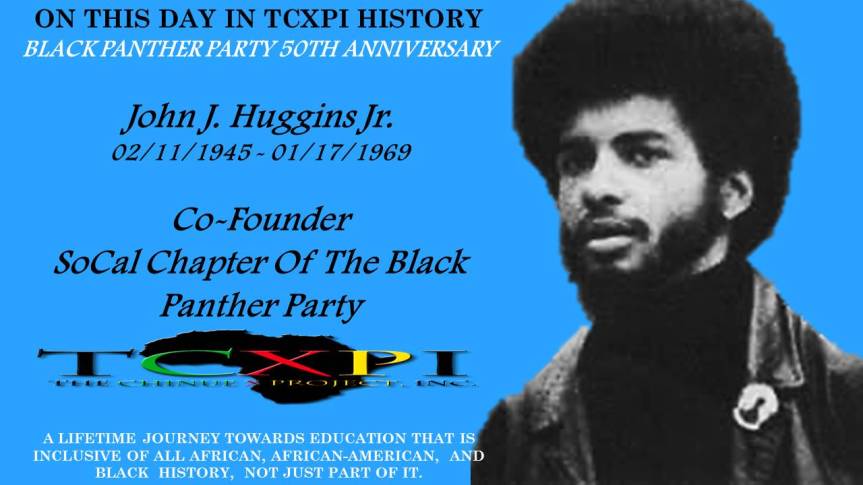
On This Day In TCXPI History
(The Chinue X Project, Inc.) TCXPI Presents The Black Panther Party 50th Anniversary
October Is Black Panther Party Month! October 23
Rise In Power John J. Huggins Jr., Co-Founder of the Southern California Black Panther Party For Self Defense,
On January 17, 1969, Black Panther Party, Alprentice “Bunchy” Carter and John Huggins, were slain on the campus of UCLA.
Students at the time, Carter and Huggins were shot during a meeting about the formation of a black studies department. The killings at Campbell Hall appeared to be a flashpoint in a supposed power struggle between the Panthers and the Maulana “Ron” Karenga-led group, Us. The FBI, under J. Edgar Hoover, however, was keen to exploit and heighten tensions between the groups before the incident.
In September 1968, a few months before Carter’s and Huggins’ deaths, the Black Panther Party had grown nationally across the United States to the extent that Hoover, as head of the FBI, designated the group as “the most dangerous threat to the internal security of the country.” The much-cited classification was followed in 1969 with an aggressive implementation of the counter-intelligence program aimed at dismantling the party, commonly known as COINTELPRO. The year began with the killings of Carter and Huggins in Los Angeles and ended with the murder of Chairman Fred Hampton and Mark Clark in Chicago.
Elaine Brown, a member of the Southern California chapter of the party at the time and the first woman to go on and lead it, remembers well the tumult of that year, one she describes as “absolute terror.”
Gabriel San Roman for Truthout: What did 1969 mean for the Southern California chapter of the Black Panther Party in terms of police repression?
Elaine Brown: In Southern California, we took some very heavy hits from the police. The most striking thing we can start out with is that the Los Angeles Police Department formed something called the Special Weapons And Tactics team, known as SWAT. That’s important historically because there were no such urban guerrilla, counterinsurgency, armylike entities in any police department prior to that. LAPD was unique in forming that and set a model. Their whole purpose was to attack the Black Panther Party. On their insignia they have “41st,” which references where they raided our offices, at 41st and Central.
Looking back, the siege of ’69 started the month before the new year, did it not?
In December of 1968, one of our comrades, Frank “Franco” Diggs, was killed in an alley in Long Beach. We, to this minute, can’t trace how that happened. Franco was one of the key figures in the formation of the chapter and probably one of the people closest to Bunchy Carter, who was the founder and had previously been one of the main leaders of the Slausons, a street organization, a gang, the second-largest in the nation. The year really started out with the murder of Franco Diggs. And then on January 17, at UCLA, John Huggins, deputy chairman, and Carter were assassinated by members of Ron Karenga’s Us organization, or a member at least, that we know of. Interestingly, that assassin was able to escape prosecution – and the United States – and ended up in Guyana. Later the “Stiner brothers,” who were also Us members that were indicted and convicted as conspirators in the murders, were sentenced (to) San Quentin prison. Miraculously, both of them escaped and also ended up in Guyana.
Was there the suspicion that this UCLA slaying came out of COINTELPRO?
There’s testimony from a former FBI informant and other testimonies that suggested there was direct FBI involvement in this assassination. The Black Panther Party at the time and I would say today say that this was absolutely an act carried out by COINTELPRO. That was the beginning of a raging year. This year, of course, was an important year, because J. Edgar Hoover had in 1968 declared publicly that the Black Panther Party was the greatest threat to the internal security of the United States. This is a rather infamous quote of his. This was Hoover’s pledge and declaration. So 1969 was the year we were supposed to be wiped out, and we almost were.
And as the year came to a close, there was a literal siege of the Southern California chapter’s office. What were your recollections of that?
In our chapter, we had two members of the San Diego branch who were shot and killed selling newspapers. We had a number of other people killed that year, like Nathaniel Clark. Then, as we got toward the end of the year, we had the assault on our office. I think it still exists as the most violent and longest assault on any citizen organization ever in the history of the country – including the assault on the MOVE organization by the Philadelphia police and the SLA in Los Angeles. The assault on our office lasted over 5½ hours with over 300 LAPD and SWAT team members hitting it with everything from grenades to helicopter rifle guns. There were 11 people in our office, of which two were women. They were able to defend the office and their lives, though they did end up going up to prison. Ironically, nobody was ever ultimately convicted of any real crime, so we have to ask ourselves why did the LAPD even come to the door in the first place? Typically, the excuse was they had a warrant for some guns suspected to be in the office.
What followed after that brought the year of repression against the party to a close?
In Chicago, within days of the LA office raid, was the brutal murder of Fred Hampton and Mark Clark in the Illinois chapter. Hampton was the leader. This is the most confirmed case that the FBI orchestrated the murder of two people in the Black Panther Party. The target of that murder was Fred Hampton. This is where we have irrefutable documents to show that a person who came into the party named William O’Neal was collaborating with the police and was actually recruited by the FBI to infiltrate the party. This guy specifically came in to be an informant and even more significantly to be a provocateur, meaning O’Neal was there to instigate certain kinds of acts and behavior that would jeopardize and otherwise undermine the party. For example, O’Neal rose to become security chief, believe it or not, and ended up putting up this rigged electric chair, an incredibly horrible thing that the central committee had to have removed, but it was there, supposedly, in case someone was suspected of being an agent. So that’s how the year ended in December of 1969. In between, there were all of these events and raids on other offices across the country, but these are the most startling ones. Our chapter really took a very heavy hit. There were just so many conflicts and acts of aggression on the party by the police that it was just a year of absolute terror.
Rise in Power John Huggins!
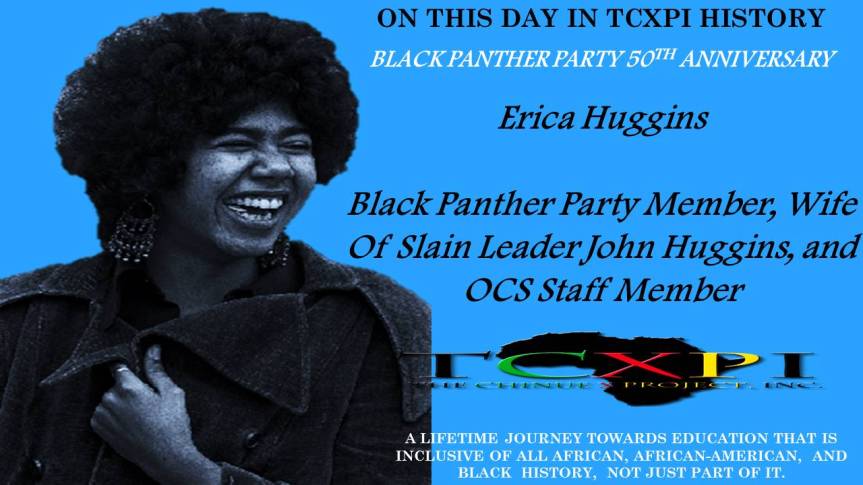
On This Day In TCXPI History
(The Chinue X Project, Inc.) TCXPI Presents The Black Panther Party 50th Anniversary
October Is Black Panther Party Month! October 24
Ericka Huggins
Ericka Huggins is a human rights activist, poet, educator, Black Panther leader and former political prisoner. For the past 30 years, she has lectured throughout the United States and internationally. Her extraordinary life experiences have enabled her to speak personally and eloquently on issues relating to the physical and emotional well-being of women, children and youth, whole being education, over incarceration, and the role of the spiritual practice in sustaining activism and promoting change.
As a result of her 14-year tenure as a leader of the Black Panther Party (the longest of any woman in leadership), she brings a unique, complete and honest perspective to the challenges and successes of the Black Panther Party and, its significance today. Currently Ericka Huggins is professor of Sociology and African-American Studies in the Peralta Community College District, she brings her legacy of social activism and spiritual practice to her lectures and classroom facilitation.
Ericka’s desire to serve humanity began in 1963, when she attended the March on Washington for Jobs and Freedom. There, she committed to moving from the sidelines to the frontlines in the global human rights movement. In 1968, at age 18, she became a leader in the Los Angeles chapter of the Black Panther Party with her husband John Huggins.
Three weeks after the birth of their daughter, John Huggins was killed and Huggins was widowed. After returning to New Haven, Connecticut to be with John’s family, Ericka was invited by community members and students to open a party chapter there. She accepted the invitation.
In May 1969, Huggins and fellow Party leader Bobby Seale were targeted and arrested on conspiracy charges sparking “Free Bobby, Free Ericka” rallies across the country. The resulting trial, one of the longest and most celebrated of the era, spawned several books.
While awaiting trial for two years before charges were dropped, including time in solitary confinement, Huggins taught herself to meditate as a means to survive incarceration. From this time on, she would incorporate spiritual practice into daily life, her community work and teaching as a tool for change – not only for herself, but for all people.
A lifelong writer and poet, upon release from prison in 1971, Ericka became writer and editor for the Black Panther Intercommunal News Service.
In 1974, her book of poetry chronicling her experience of imprisonment and liberation, Insights and Poems, co-authored with Huey P. Newton, was published. Her poetry and writings have appeared in numerous magazines and books.
From 1973-1981, Huggins was Director of the Oakland Community School, a groundbreaking community-run child development center and elementary school founded by the Black Panther Party. She created the vision for the innovative curriculum for the school, which became a model for and predecessor to the charter school movement.
In 1976, Ericka Huggins became both the first woman and the first Black person to be appointed to the Alameda County Board of Education.
Sources: http://www.erickahuggins.com/Biography.html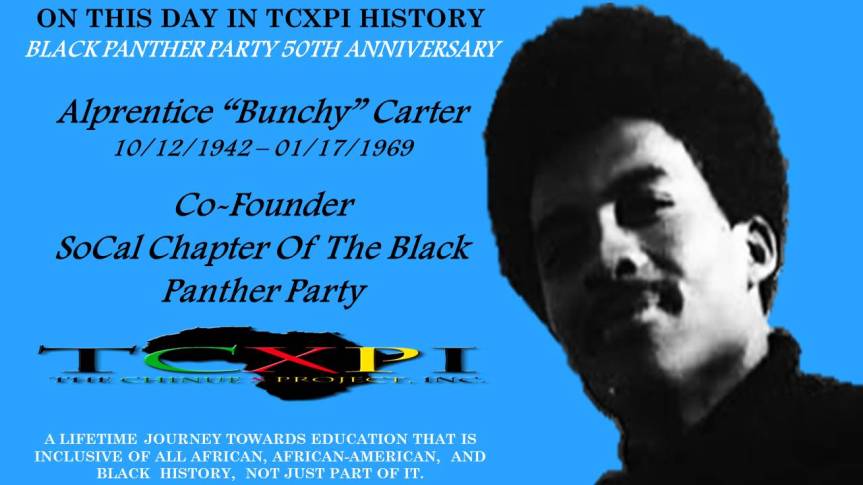
On This Day In TCXPI History
(The Chinue X Project, Inc.) TCXPI Presents The Black Panther Party 50th Anniversary
October Is Black Panther Party Month! October 25
In 1968 “Bunchy” Carter formed Southern California chapter of the BPP with John Huggins and became a leader in the group. On January 17, 1969, “Bunchy” Carter and fellow Panther John Huggins were shot to death in UCLA’s Campbell Hall by members of the rival black radical group Us. Huggins and fellow Party leader Bunchy Carter were gunned down by members of the US Organization during a 1969 meeting at UCLA. Their deaths were actual set up by the FBI and its COINTELPRO program.
Revolutionary hero Alprentice “Bunchy” Carter was the leader of the Los Angeles chapter of the Black Panther Party until his death, which was instigated, promoted, and possibly even carried out by the FBI in 1969.
Born in 1942, Carter had been exposed to crime early in life. He was the leader of a street gang called The Slausons, which belonged to the hardcore Renegade faction. He was called “Mayor of the Ghetto” by many, and served time in prison for armed robbery. During his incarceration, he became radicalized, first by joining the Nation of Islam like many other Black people who found themselves captured by the criminal injustice system at that time.
After meeting Eldridge Cleaver of the Black Panther Party (BPP), Carter renounced the Nation of Islam, dedicated himself to the fight for Black liberation, and joined the Black Panthers in 1967.
In early 1968, Carter returned to his native Los Angeles and founded the soon-to-be very prominent and successful BPP-LA chapter. Later that year, the BPP-LA was admitting 50 to 100 new members a week, and a comprehensive and rigorous study of BPP literature, politics, firearms, and first-aid training was developed.
The presence of a skilled and disciplined black liberation movement in Los Angeles was unconscionable and intolerable to both the Los Angeles Police Department (LAPD) and the FBI. A campaign to undermine and ultimately destroy the BPP was launched.
With the election of “law and disorder” candidate Richard Nixon in 1969, the campaign against the party became more brutal and violent in form. BPP offices around the country were shot by police agencies, and Panthers were arrested without cause, beaten, killed, and generally subjected to a campaign of unprecedented brutality and abuse.
During this time, the FBI’s COINTELPRO program made use of a wide array of informants, and established a very successful system of using one organization to destroy another. In Los Angeles, the antagonistic party was filled by Ron Karenga’s US (pronounced “us”) organization, a cultural nationalist group that had several theoretical and practical contradictions with the BPP party that often turned into violent altercations and power struggles.
One such conflict took place at UCLA, during which US and the BPP were vying for control of the school’s African-American studies center. On January 17, 1969, the US organization shot and killed Bunchy Carter and comrade John Huggins at UCLA’s Campbell Hall after an altercation during a meeting of the school’s Black Student Union. The LAPD responded by raiding BPP apartments and arresting 75 members, despite the Panthers having committed no violence at the meeting. The US organization continued their violent campaign against the Panthers, killing more members of the organization throughout 1969.
This is one of the myriad of examples of the white supremacist, capitalist, imperialist power structures taking advantage of intra-ethnic factionalism and cliquishness to effectively suppress revolutionary movements in the United States. The lesson for contemporary black revolutionaries today is to resolve conflicts and contradictions among our people and society as a whole through principled, nonviolent actions, and not through counterrevolutionary violence that is promoted and propagated by our enemies. Long live the memory of Bunchy Carter and John Huggins!
Source: https://blackthen.com/alprentice-bunchy-carter-murdered-to-dismantle-the-black-panther-party/

On This Day In TCXPI History
(The Chinue X Project, Inc.) TCXPI Presents The Black Panther Party 50th Anniversary
October Is Black Panther Party Month! October 26
Rap Brown and Stokely Carmichael (Kwame Ture) two Leaders of the Student Nonviolent Coordinating Committee (SNCC) who also become Leaders in the Black Panther Party Of Self Defense. H. Rap Brown became Minister Of Justice and Stokely Carmichael became Prime Minister while still active SNCC Leaders.
In the mid-Sixties, Brown and Carmichael together were key activists in the Lowndes County Freedom Organization, an Alabama group whose flag sported the image of a black panther. Both men rejected Martin Luther King, Jr.’s nonviolent and integrationist politics, and called instead for “Black Power.” Brown’s most famous statement was, “Violence is as American as apple pie.” He commonly referred to President Lyndon Johnson as a “mad, wild dog” and a “honkie cracker.” “If you give me a gun,” Brown warned, “I just might shoot Lady Bird” (Mrs. Johnson). In the aftermath of the violent 1967 race riots in Newark, New Jersey, Brown exhorted black people to “wage guerrilla war on the honkie white man.”
In July 1967 Brown was arrested for inciting a riot at a civil-rights rally in Cambridge, Maryland. At that event, he declared: “Black folks built America, and if America don’t come around, we’re going to burn America down. We are going to burn it down if we don’t get our share of it.” Moreover, Brown urged his listeners to “get you some guns” because “the only thing a honkie respects is force.” “Don’t try loving a honkie to death,” he added. “Shoot him to death. Shoot him to death, brother, ’cause that’s what he’s out to do to you.”
On various other occasions in 1967, Brown accused the white power structure of “escalating genocide” against blacks; said that black U.S. soldiers in Vietnam should return home to “fight the real war”; urged black women who worked for white families to serve their employers food sprinkled with “arsenic instead of salt”; and called for arson and mass rioting in American cities.
At a 1968 rally in Oakland, California, Brown was named the Minister of Justice for the Black Panther Party. That same year, he wrote his first book, Die Nigger Die, in which he claimed that white people wanted all blacks dead. Then, rather than face criminal charges stemming from the Cambridge incident of 1967, Brown jumped bail and disappeared for two years, thereby earning himself a spot on the FBI’s “Ten Most Wanted” list.
Source: https://thoughtprovokingperspectives.co/tag/stokely-carmichael/
Additional Source: http://www.discoverthenetworks.org/individualProfile.asp?indid=1308

On This Day In TCXPI History
(The Chinue X Project, Inc.) TCXPI Presents The Black Panther Party 50th Anniversary
October Is Black Panther Party Month! October 27
Rise In Power Afeni Shakur, Black Panther Member, Philanthropist, Political Activist, and Businesswoman
As the saying goes, “never forget where you came from.” Let’s not forget where Tupac Shakur came from. Her name is Afeni Shakur- Davis, born Alice Faye Williams on January 22, 1947; she died May 2, 2016.
Ms. Afeni Shakur was a businesswoman, philanthropist, former political activist, and former Black Panther. She was the mother of the late Tupac Shakur. She acted as her own criminal defense attorney after being accused of participating in many bombings as a member of the Panther 21.
Afeni Shakur founded the Georgia-based Tupac Amaru Shakur Foundation, which provides art programs for youth, and Amaru Entertainment, the holding business for all Tupac’s unreleased projects.
The name Afeni was given to her by an African-American man who built a Yoruba village in South Carolina. Afeni means “dear one” or “lover of the people.“
Afeni Shakur joined the Black Panther Party in 1968. She says she did not come off the college campuses like many of the other known Panthers. She came from the streets of the South Bronx. She said the Panther Party gave her home training.
When Afeni Shakur was incarcerated she was pregnant with Tupac and she would rub her stomach saying, “This is my prince, he is going to save the black nation.” By the time Tupac was born on June 16, 1971, Afeni had already defended herself in court and been acquitted on 156 counts.
Living in the Bronx, she worked as a paralegal and tried to raise her son to respect the value of an education. From childhood, everyone called Tupac the “Black Prince.” Afeni named him Tupac Amaru Shakur (Shining, Serpent, Blessed One). She wanted him to have the name of a revolutionary.
Source: https://soapboxie.com/activism/AfeniShakur
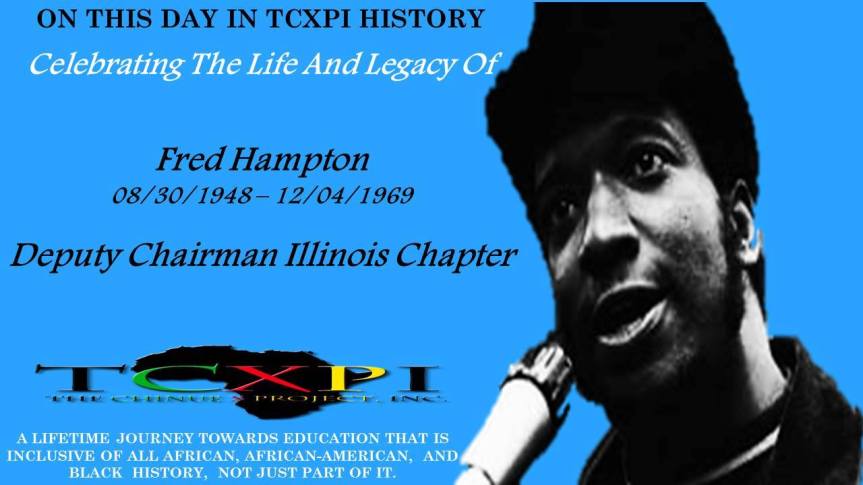
On This Day In TCXPI History
(The Chinue X Project, Inc.) TCXPI Presents The Black Panther Party 50th Anniversary
October Is Black Panther Party Month! October 28
Fred Hampton, deputy chairman of the Illinois chapter of the Black Panther Party, was born on August 30, 1948 and raised in the Chicago suburb of Maywood, Illinois. In high school he excelled in academics and athletics. After Hampton graduated from high school, he enrolled in a prelaw program at Triton Junior College in River Grove, Illinois. Hampton also became involved in the civil rights movement, joining his local branch of the National Association for the Advancement of Colored People (NAACP). His dynamic leadership and organizational skills in the branch enabled him to rise to the position of Youth Council President. There Hampton mobilized a racially integrated group of five hundred young people who successfully lobbied city officials to create better academic services and recreational facilities for African American children.
In 1968, Hampton joined the Black Panther Party (BPP), headquartered in Oakland, California. Using his NAACP experience, he soon headed the Chicago chapter. During his brief BPP tenure, Hampton formed a “Rainbow Coalition” which included Students for a Democratic Society, the Blackstone Rangers, a street gang and the National Young Lords, a Puerto Rican organization. Hampton was also successful in negotiating a gang truce on local television.
In an effort to neutralize the Chicago BPP, the Federal Bureau of Investigation (FBI) and the Chicago Police Department placed the chapter under heavy surveillance and conducted several harassment campaigns. In 1969, several BPP members and police officers were either injured or killed in shootouts and over one hundred local members of the BPP were arrested.
During an early morning police raid of the BPP headquarters at 2337 W. Monroe Street on December 4, 1969, twelve officers opened fire, killing the 21 year old Hampton and Peoria, Illinois Panther leader Mark Clark. Police also seriously wounded four other Panther members. Many in the Chicago African American community were outraged over the raid and what they saw as the unnecessary deaths of Hampton and Clark. Over 5,000 people attended Hampton’s funeral where Reverends Ralph Abernathy and Jesse Jackson of the Southern Christian Leadership Conference eulogized the slain activist. Years later, law enforcement officials admitted wrongdoing in the killing of Hampton and Clark. In 1990 and later in 2004 the Chicago City Council passed resolutions commemorating December 4 as Fred Hampton Day.
See more at: http://www.blackpast.org/aah/hampton-fred-1948-1969#sthash.ZJxL6GuV.dpuf
Source:
http://www.blackpast.org/aah/hampton-fred-1948-1969
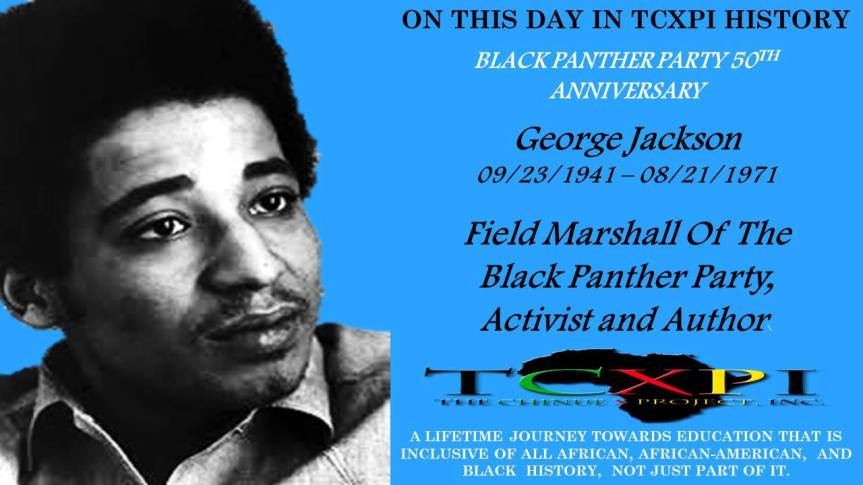
On This Day In TCXPI History
(The Chinue X Project, Inc.) TCXPI Presents The Black Panther Party 50th Anniversary
October Is Black Panther Party Month! October 29
Salute to George Jackson! Rise In Power!
Author George Jackson is best known for his memoir Soledad Brother, containing the letters that he wrote from prison between 1964 and 1970. George Lester Jackson was born on September 23, 1941, on the west side of Chicago, Illinois. The second of five children, Jackson’s parents provided him with a relatively stable home. After he encountered violence in a public school, his parents moved him to the St. Malachy School, a black Catholic school that he attended for ten years.
During the summers, Jackson would visit his grandmother and aunt in the rural areas of southern Illinois every summer where he developed an independent streak, learning to use firearms and hunt animals. In 1956, the Jackson family moved to Los Angeles to escape bad influences in their Chicago neighborhood.
Before long though, George Jackson had joined a street gang called the Capones. At the age of 15 he was arrested for stealing a motorcycle. After several other burglary attempts and subsequent arrests, Jackson was sent to a California youth authority facility in Paso Robles. After his release he was suspected in another string of robberies and again arrested. The criminal activity rapidly caught up with Jackson, who on February 1st, 1961 was sentenced to one year to life in state prison for the $71 armed robbery of a gas station. He was imprisoned at the California Training Facility in Soledad, California.
Jackson spent the next few years being transferred between California prisons, often in solitary confinement, and became immersed in radical political theory that he learned from fellow inmate W.L. Nolen. Jackson was returned to Soledad Prison in January 1969 and in 1970 was accused along with two other convicts of killing a guard. Jackson and the other two convicts would become known as the Soledad Brothers. A collection of Jackson’s letters was published as Soledad Brother: The Prison Letters of George Jackson (1970), which rapidly gained popular mainstream support.
On August 7th, 1970, Jackson’s younger brother Jonathan attempted to break the Soledad Brothers from prison by taking hostages in a Marin County, California courtroom. Police opened fire on the hostage takers. When the gunfire stopped, Jonathan and two of his three co-conspirators lay dead, as well as a judge who had been taken hostage.
The Soledad Brothers were transferred to a high-security section of San Quentin Prison in summer 1971. On August 21st, 1971 Jackson was killed while attempting to escape from San Quentin during an armed prisoner insurrection that left six people dead. How Jackson’s death occurred remains controversial but the official report was that he somehow was passed a firearm by his lawyers and was shot by prison guards in an escape attempt.
His book Blood in My Eye was published posthumously in 1972.
See more at: http://www.blackpast.org/aaw/jackson-george-1941-1971#sthash.PxLD32pJ.dpuf
Source:
BlackPast.Org
http://www.blackpast.org/aaw/jackson-george-1941-1971

(The Chinue X Project, Inc.) TCXPI Presents The Black Panther Party 50th AnniversaryMumia Abu-Jamal, Black Panther Party, Philadelphia Chapter.
October Is Black Panther Party Month! October 30Political Activist and Journalist Mumia Abu-Jamal was born in Philadelphia, Pennsylvania on April 24, 1954.
Born Wesley Cook, he took the name Mumia (“Prince”) in high school while taking a class on African cultures. In 1971, he added Abu-Jamal (“father of Jamal”) after the birth of his first son, Jamal. He has been married three times.
Abu-Jamal’s first encounter with the police came when he was 14. He was beaten by a white Philadelphia police officer for disrupting a “George Wallace for President” rally in 1968. Eventually he dropped out of high school and joined the Philadelphia chapter of the Black Panther Party. Jamal was appointed BPP’s “Lieutenant of Information,” putting him in charge of the organization’s media relations and placing him on the radar for surveillance by the Federal Bureau of Investigation (FBI). He eventually earned his graduate equivalency high school degree (GED) and briefly attended Goddard College in Vermont.
In 1975 Abu-Jamal began working for a series of radio stations, using his commentary on issues of the day to advocate for social change. Due to his growing popularity he was elected president of the Philadelphia Association of Black Journalists. Despite his popularity, Abu-Jamal was forced to take a second job as a taxi driver to supplement his income.
Abu-Jamal became nationally prominent, however, when he was arrested for the murder of Philadelphia policeman Daniel Faulkner. On December 9, 1981, Faulkner was shot and killed during a routine traffic stop involving Jamal’s brother, William Cook. During the scuffle between Faulkner and Cook, Abu-Jamal also was shot and taken to Thomas Jefferson University Hospital. He was treated and then arrested and charged with first-degree murder. In June 1982, Abu-Jamal was tried. Despite conflicting testimony from key witnesses, Abu-Jamal was found guilty and sentenced to death. In 1994, Abu-Jamal returned to radio once again as a commentator for Prison Radio and for National Public Radio. His NPR commentaries were compiled in 1995 as part of Live from Death Row, which resulted in Abu-Jamal’s punishment of solitary confinement for engaging in entrepreneurship from prison.
In 1999, Arnold Beverly admitted that he and an unnamed assailant, not Abu-Jamal, had shot Faulkner as part of a contracted killing because the officer was interfering with graft and payoff to corrupt police. Soon afterwards some prosecutors’ witnesses in the trial came forward and admitted that they lied under oath. Abu-Jamal and his supporters pressed for a new trial based on these recent developments. Their efforts paid off in 2008 when a three-judge panel reopened the case. The panel however chose to uphold the conviction, and Jamal is still in prison awaiting the death penalty. Mumia Abu-Jamal still maintains his innocence, and many people believe him, thus making him one of the most closely followed convicts in the world.
See more at: http://www.blackpast.org/aah/mumia-abu-jamal-1954#sthash.oAlqKztu.dpuf
Source:
BlackPast.Org
http://www.blackpast.org/aah/mumia-abu-jamal-1954
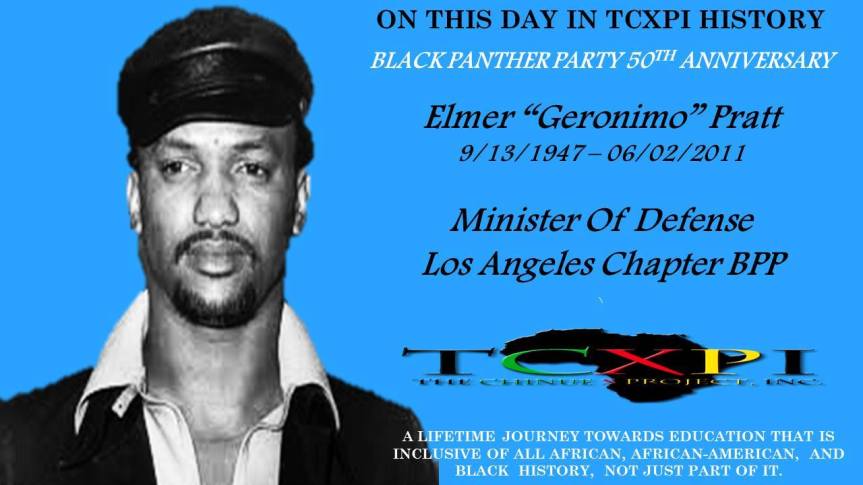
On This Day In TCXPI History
(The Chinue X Project, Inc.) TCXPI Presents The Black Panther Party 50th Anniversary
October Is Black Panther Party Month! October 31
Elmer “Geronimo” Pratt was a high ranking Black Panther Party (BPP) leader in Los Angeles who was targeted by the United States federal government’s domestic surveillance COINTELPRO program. He was accused and convicted of a murder and spent twenty-seven years in prison but the conviction was later vacated and he was released. Geronimo Pratt was born on September 13, 1947 in Morgan City, Louisiana and had six siblings.
His parents, Jack and Eunice Pratt, earned a living by operating a small scrap metal salvaging business. Geronimo was an exceptional student and played quarterback for the high school football team. In 1965, Pratt joined the army and was sent to Vietnam. He served two tours in Vietnam with distinction, earning two Bronze Stars, a Silver Star, and two Purple Hearts. He was honorably discharged in 1968.
Pratt moved to Los Angeles after returning from Vietnam and he enrolled at UCLA using the GI Bill. There he met Alprentice “Bunchy” Carter, who was the leader of the Southern California chapter of the BPP. Pratt joined the BPP and after Carter was murdered in 1969, he was named deputy minister of defense and head of the Los Angeles chapter of the BPP. He became a target of the Federal Bureau of Investigation (FBI) and its counterintelligence, surveillance, and disruption program COINTELPRO. The government accused Pratt of the 1968 murder of Caroline Olsen, a schoolteacher. Olsen had been shot during a robbery in Santa Monica, California. Pratt’s legal defense team included a young Johnnie Cochran. The defense team argued that Pratt was 350 miles away during the time of the murder at a BPP meeting, and Caroline Olsen’s husband, who was also shot but survived, identified another man as the killer. However, Pratt was found guilty, largely based on the witness testimony of Julius “Julio” Butler. Pratt spent twenty-seven years in prison, eight of those years in solitary confinement. Johnnie Cochran continued to work on his case, and he was joined by a radical law student, Stuart Hanlon. Pratt was granted a new trial in 1996 and was released in 1997, with the judge ruling that the original conviction should be vacated because the Los Angeles district attorney’s office had concealed crucial information from the jury, such as the fact that the key witness for the prosecution, Julio Butler, was a paid FBI and police informant. Pratt also won a civil suit for wrongful imprisonment and was awarded a $4.5 million settlement. After being released from prison, Pratt dedicated his life to working for those wrongfully incarcerated. He moved to Tanzania with the daughter of Eldridge and Kathleen Cleaver and that is where he passed away on June 2, 2011.
– See more at: http://www.blackpast.org/aah/pratt-geronimo-1947-2011#sthash.ge6rPq04.dpuf
Source: http://www.blackpast.org/aah/pratt-geronimo-1947-2011


